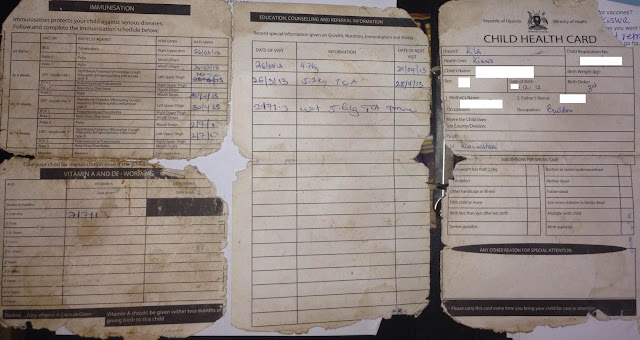Can a Wall Hanging Prevent Diseases?
Vaccines are another important and cost-effective way to prevent illness in the slums. Common slum diseases such as pneumonia (caused by pneumococcal or H. influenzae bacteria), rotavirus (which causes up to 40% of diarrheal deaths), whooping cough and tuberculosis can be prevented with vaccines.
Most families in the slums understand and agree that vaccines are beneficial for their children. The government of Uganda is supposed to offer free vaccinations for all children. However, there are various barriers and challenges at each step of the process which make it difficult for low-income parents to immunize their children completely, on time, and sometimes even at all. These challenges include vaccine shortages at clinics, limited clinic hours for vaccines, long waiting lines, issues with proper storage and refrigeration of vaccines, costs of transportation to the clinic, rude and demeaning health care personnel, and private clinics that charge fees for administering vaccines. For families that are struggling to survive day to day, surmounting all of these barriers to get preventive health visits for their children often doesn't feel worth it.
Additional challenges include shortages of government-issued home based records which means that families do not have a record of which immunizations their child has received. For families that do have a home-based record, these cards easily become lost or damaged as they are kept in crowded slum homes. Many families have low-literacy skills and struggle to understand what is written on these cards, which means they do not know when to take their children back to the clinic for future vaccinations.
When creating our respiratory health project, we knew we wanted to do something to address these challenges with vaccination, but did not know where to begin in the face of such systemic challenges. I came across a simple intervention which was done among low-literacy mothers in another country to help remind families when it was time to go to the clinic for vaccinations. The intervention substantially increased rates of vaccination in a poor community. Families were provided with a plastic sleeve for their vaccine card which could be hung on the wall prominently at home. An additional colorful card was inserted in the sleeve which holds only one piece of information: the date of the next immunization visit in large print. This card serves as a constant reminder of the next clinic date, while also preserving and protecting the vaccine record.
We have decided to replicate this intervention in our communities. We know this will not solve the myriad systemic problems with immunizations, but at least it will address a few of the barriers that are specific to our communities. Most of all, it will help to empower families with health knowledge and to give them confidence that their children are getting the protection that they need.
Here is an example of a typical Child Health Card:



Comments
Post a Comment